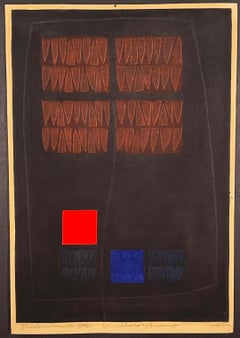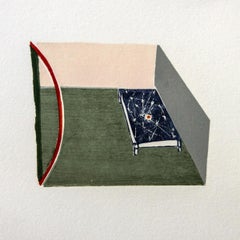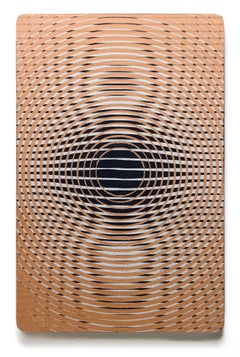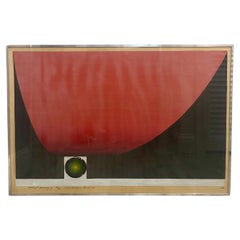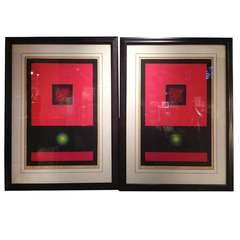Kunihiro Amano Art
to
1
1
1
ENCLOSURE 12
By Kunihiro Amano
Located in Portland, ME
Amano, Kunihiro (Japanese, born 1929). ENCLOSURE 12. Color Woodblock, not dated. Edition of 30. Titled, Numbered 21/30, and signed in pencil. 18 x 13 1/2 inches. In excellent condit...
Category
Mid-20th Century Kunihiro Amano Art
Materials
Woodcut
Related Items
Room with a red arch - XXI Century, Contemporary Linocut Woodcut Print, Colorful
By Maria Stelmaszczyk
Located in Warsaw, PL
Maria Stelmaszczyk is a Polish artist born in 1983.
PROVENANCE
Exhibited at Katarzyna Napiorkowska Gallery.
The Gallery is a primary representative for this artist.
The Gallery o...
Category
Early 2000s Contemporary Kunihiro Amano Art
Materials
Paper, Woodcut, Linocut
"Portal I", Abstract Patterns, Geometric Abstraction, Woodcut Monoprint on Panel
Located in Philadelphia, PA
This piece titled "Portal I" is an original piece by Alexis Nutini and is made from a woodcut monoprint mounted on panel. This piece measures 14.5"h x 9.5"w.
Born in Mexico City, A...
Category
21st Century and Contemporary Contemporary Kunihiro Amano Art
Materials
Panel, Monoprint, Woodcut, Paper
Lotus
By Hiroki Morinoue
Located in Lyons, CO
Color woodcut, Edition 30.
Lotus is a twenty-six color woodcut from seven woodblocks printed in an edition of 30, plus proofs, on white Thai Mulberry paper. In this print, a compe...
Category
21st Century and Contemporary Contemporary Kunihiro Amano Art
Materials
Woodcut
Metamorphosis of Zan Biell, Abstract Woodcut on Rice Paper by Keisuke Serizawa
By Keisuke Serizawa
Located in Long Island City, NY
Artist: Keisuke Serizawa, Japanese (1895-1984)
Title: Metamorphosis of Zan Biell
Year: circa 1970
Medium: Woodcut on Rice Paper, signed and numbered in pencil
Edition: AP
Size: 29 x...
Category
1970s Abstract Expressionist Kunihiro Amano Art
Materials
Rice Paper, Woodcut
$1,000 Sale Price
20% Off
H 29 in W 23.5 in
"Follow Me", Abstract Patterns, Geometric Abstraction, Woodcut Monotype on Panel
Located in Philadelphia, PA
This piece titled "Follow Me" is an original piece by Alexis Nutini and is made from a woodcut monoprint mounted on panel. This piece measures 9.5"h x 14.5"w.
Born in Mexico City, ...
Category
21st Century and Contemporary Contemporary Kunihiro Amano Art
Materials
Panel, Monoprint, Woodcut
"Follow", Abstract Patterns, Geometric Abstraction, Woodcut Monoprint on Panel
Located in Philadelphia, PA
This piece titled "Follow" is an original piece by Alexis Nutini and is made from a woodcut monoprint mounted on panel. This piece measures 7.25"h x 9.5"w.
Born in Mexico City, Ale...
Category
21st Century and Contemporary Contemporary Kunihiro Amano Art
Materials
Panel, Monoprint, Woodcut
Orange labyrinth - XXI Century, Contemporary Linocut & Woodcut Print, Abstract
By Maria Stelmaszczyk
Located in Warsaw, PL
MARIA STELMASZCZYK (born in 1983) Studies at the Faculty of Graphic Arts and Painting
Laboratory of Woodcut Techniques and Artistic Book at the Academy of Fine Arts Władysław Strzemi...
Category
Early 2000s Contemporary Kunihiro Amano Art
Materials
Paper, Linocut, Woodcut
Gravure pour 10 Origine - Woodcut by Vasilij Kandinskij - Mid-20th Century
Located in Roma, IT
Gravure pour 10 origine is an original modern artwork realized by Vasilij Kandinskij
Black and white woodcut
Numbered on the lower margin.
Edition of 10/75.
This is the second e...
Category
Mid-20th Century Abstract Kunihiro Amano Art
Materials
Woodcut
$1,437
H 15.16 in W 11.03 in D 0.04 in
Non-accidental shapes - XX Century, Colorful Woodcut , Abstract Print
By Ryszard Gieryszewski
Located in Warsaw, PL
RYSZARD GIERYSZEWSKI (born in 1936)
Graduated from the Academy of Fine Arts in Warsaw in 1964. He is a member of International Association XYLON in Switzerland. He participated in mo...
Category
Early 2000s Abstract Kunihiro Amano Art
Materials
Paper, Woodcut
$778
H 23.63 in W 16.93 in
Untitled (A border) - XX Century Contemporary Woodcut , Abstract Print, Relief
By Ryszard Gieryszewski
Located in Warsaw, PL
RYSZARD GIERYSZEWSKI (born in 1936)
Graduated from the Academy of Fine Arts in Warsaw in 1964. He is a member of International Association XYLON in Switzerland. He participated in mo...
Category
1980s Abstract Kunihiro Amano Art
Materials
Paper, Woodcut
April 2012 - XXI Century Contemporary Woodcut , Abstract Print, Red Color Accent
By Ryszard Gieryszewski
Located in Warsaw, PL
RYSZARD GIERYSZEWSKI (born in 1936)
Graduated from the Academy of Fine Arts in Warsaw in 1964. He is a member of International Association XYLON in Switzerland. He participated in mo...
Category
2010s Abstract Kunihiro Amano Art
Materials
Paper, Woodcut
Ariadne by Jill Moser
By Jill Moser
Located in New York, NY
Jill Moser, Ariadne, 2021
Woodcut print on Khadi 100 % cotton paper
Signed and numbered by the artist on recto
Paper size: 8.25 x 8 in
Edition of 18
Published by Eminence Grise Editions, New York
Printed by Andrew Mockler...
Category
2010s Abstract Expressionist Kunihiro Amano Art
Materials
Woodcut
Previously Available Items
“Distant Memory” Wood Block Print by Japanese artist Kunihiro Amano, 1968
By Kunihiro Amano
Located in Boynton Beach, FL
Exceptional wood block print by Japanese artist Kunihiro Amano.
Titled “Distant Memory”
Hand signed in pencil.
Numbered 30/50
1968.
A beautiful ...
Category
Mid-20th Century North American Mid-Century Modern Kunihiro Amano Art
Materials
Paper
Pair Kunihiro Amano Wood Cuts Titled Fossil
By Kunihiro Amano
Located in Westport, CT
Pair 1970 Signed and dated Kunihiro Amano,Born 1929 Japanese Artist 1970 each framed in black frame,wonderful deep red color with texture and dimension ...
Category
1970s Japanese Mid-Century Modern Vintage Kunihiro Amano Art
Kunihiro Amano art for sale on 1stDibs.
Find a wide variety of authentic Kunihiro Amano art available for sale on 1stDibs. If you’re browsing the collection of art to introduce a pop of color in a neutral corner of your living room or bedroom, you can find work that includes elements of red and other colors. You can also browse by medium to find art by Kunihiro Amano in woodcut print and more. Not every interior allows for large Kunihiro Amano art, so small editions measuring 20 inches across are available. Customers who are interested in this artist might also find the work of Katsunori Hamanishi, Shigeru Taniguchi, and Risaburo Kimura. Kunihiro Amano art prices can differ depending upon medium, time period and other attributes. On 1stDibs, the price for these items starts at $1,200 and tops out at $1,200, while the average work can sell for $1,200.
